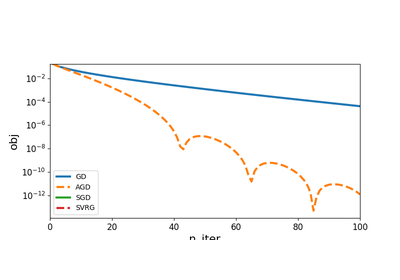tick.solver.SGD¶
-
class
tick.solver.SGD(step: float = None, epoch_size: int = None, rand_type: str = 'unif', tol: float = 1e-10, max_iter: int = 100, verbose: bool = True, print_every: int = 10, record_every: int = 1, seed: int = -1)[source]¶ Stochastic gradient descent solver
For the minimization of objectives of the form
\[\frac 1n \sum_{i=1}^n f_i(w) + g(w),\]where the functions \(f_i\) have smooth gradients and \(g\) is prox-capable. Function \(f = \frac 1n \sum_{i=1}^n f_i\) corresponds to the
model.lossmethod of the model (passed withset_modelto the solver) and \(g\) corresponds to theprox.valuemethod of the prox (passed with theset_proxmethod). One iteration ofSGDcorresponds to the following iteration appliedepoch_sizetimes:\[w^{t+1} \gets \mathrm{prox}_{\eta_t g} \big(w^t - \eta_t \nabla f_i(w^t) \big),\]where \(i\) is sampled at random (strategy depends on
rand_type) at each iteration, where \(\eta_t = \eta / (t + 1)\), with \(\eta > 0\) that can be tuned withstep. The seed of the random number generator for generation of samples \(i\) can be seeded withseed. The iterations stop whenever tolerancetolis achieved, or aftermax_iterepochs (namelymax_iter\(\times\)epoch_sizeiterations). The obtained solution \(w\) is returned by thesolvemethod, and is also stored in thesolutionattribute of the solver.- Parameters
step :
floatStep-size parameter, the most important parameter of the solver. A try-an-improve approach should be used.
tol :
float, default=1e-10The tolerance of the solver (iterations stop when the stopping criterion is below it)
max_iter :
int, default=100Maximum number of iterations of the solver, namely maximum number of epochs (by default full pass over the data, unless
epoch_sizehas been modified from default)verbose :
bool, default=TrueIf
True, solver verboses history, otherwise nothing is displayed, but history is recorded anywayseed :
int, default=-1The seed of the random sampling. If it is negative then a random seed (different at each run) will be chosen.
epoch_size :
int, default given by modelEpoch size, namely how many iterations are made before updating the variance reducing term. By default, this is automatically tuned using information from the model object passed through
set_model.rand_type : {‘unif’, ‘perm’}, default=’unif’
How samples are randomly selected from the data
if
'unif'samples are uniformly drawn among all possibilitiesif
'perm'a random permutation of all possibilities is generated and samples are sequentially taken from it. Once all of them have been taken, a new random permutation is generated
print_every :
int, default=10Print history information every time the iteration number is a multiple of
print_every. Used only isverboseis Truerecord_every :
int, default=1Save history information every time the iteration number is a multiple of
record_every- Attributes
model :
ModelThe model used by the solver, passed with the
set_modelmethodprox :
ProxProximal operator used by the solver, passed with the
set_proxmethodsolution :
numpy.array, shape=(n_coeffs,)Minimizer found by the solver
history :
dict-likeA dict-type of object that contains history of the solver along iterations. It should be accessed using the
get_historymethodtime_start :
strStart date of the call to
solve()time_elapsed :
floatDuration of the call to
solve(), in secondstime_end :
strEnd date of the call to
solve()dtype :
{'float64', 'float32'}, default=’float64’Type of the arrays used. This value is set from model and prox dtypes.
References
-
__init__(step: float = None, epoch_size: int = None, rand_type: str = 'unif', tol: float = 1e-10, max_iter: int = 100, verbose: bool = True, print_every: int = 10, record_every: int = 1, seed: int = -1)[source]¶ Initialize self. See help(type(self)) for accurate signature.
-
get_history(key=None)¶ Returns history of the solver
- Parameters
key :
str, default=NoneIf
Noneall history is returned as adictIf
str, name of the history element to retrieve
- Returns
output :
listordictIf
keyis None orkeyis not in history then output is a dict containing history of all keysIf
keyis the name of an element in the history, output is alistcontaining the history of this element
-
objective(coeffs, loss: float = None)¶ Compute the objective function
- Parameters
coeffs :
np.array, shape=(n_coeffs,)Point where the objective is computed
loss :
float, default=`None`Gives the value of the loss if already known (allows to avoid its computation in some cases)
- Returns
output :
floatValue of the objective at given
coeffs
-
set_model(model: tick.base_model.model.Model)¶ Set model in the solver
- Parameters
model :
ModelSets the model in the solver. The model gives the first order information about the model (loss, gradient, among other things)
- Returns
output :
SolverThe
Solverwith given model
-
set_prox(prox: tick.prox.base.prox.Prox)¶ Set proximal operator in the solver
- Parameters
prox :
ProxThe proximal operator of the penalization function
- Returns
output :
SolverThe solver with given prox
Notes
In some solvers,
set_modelmust be called beforeset_prox, otherwise and error might be raised
-
solve(x0=None, step=None)¶ Launch the solver
- Parameters
x0 :
np.array, shape=(n_coeffs,), default=`None`Starting point of the solver
step :
float, default=`None`Step-size or learning rate for the solver. This can be tuned also using the
stepattribute- Returns
output :
np.array, shape=(n_coeffs,)Obtained minimizer for the problem, same as
solutionattribute
